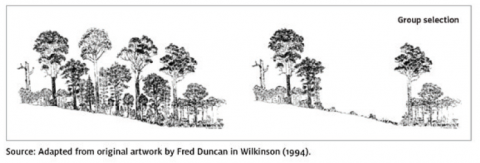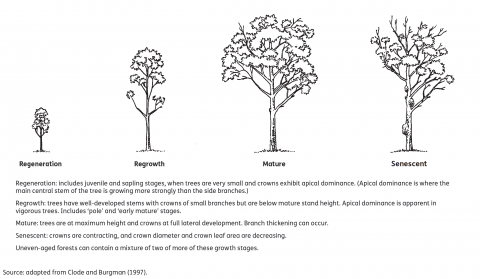Australia’s forests and forestry glossary
Forest-dwelling species
A species that may use a forest habitat for at least part of its lifecycle.
Forester
A professional who uses scientific principles to manage forests for a variety of human and environmental needs and benefits.
Forestry
The science and craft of creating, managing, conserving, using and caring for forests to meet desired goals, needs, and values, for human and environmental benefits.
Forestry operations
1. Work undertaken in the course of forest establishment and/or management for purposes including forest protection, public recreation, research, catchment protection, wood production, and the control of planned fires.
2. Operational forest management activities related to wood production.
3. The planting of trees, the managing of trees before they are harvested, or the harvesting of forest products for commercial purposes, including any related land clearing, land preparation and regeneration (including burning), and transport operations.
Formal reserve
An area, such as a national park, legally dedicated for protection in a reserve.
See CAR reserve system, Informal reserve, Management by prescription, National Reserve System.
Fragmentation
1. The degree to which forest exists in separate areas that are not spatially connected.
2. The process of loss of spatial connectivity between forest areas.
See Connectivity.
Fuel load
The total amount of combustible material in a defined area, including standing and downed wood, leaves and bark.
Fuel-reduction burn
Fire started in accordance with a fire management plan or planned burning program for the purpose of reducing fuel loads in a defined area.
See Backburning, Planned fire.
Fuelwood
Genetic diversity
The diversity of genetic information within and between individual species.
Genetic resources
Genetic material of plant, animal, microbial or other origin that has actual or potential value.
Genotype
The genetic constitution or make-up of an organism.
See Phenotype.
Genus
Geographic information system (GIS)
A system for capturing, storing, analysing and managing data and associated attributes that are spatially referenced to the surface of the Earth.
Geospatial
Relating to the relative position of features on the surface of the Earth.
Girder
A specialised, large-dimensioned, durable timber product, usually in squared-end form, that is used in building bridges, wharves and the framework of large buildings.
Global carbon cycle
The movement of carbon between different parts of the Earth’s crust, ocean, biosphere and atmosphere, including the storage of carbon in those parts.
Grafting
A method of plant propagation, whereby a bud, shoot or tissue of one plant is joined with another plant.
Green Triangle
1. A region straddling the state border between south-west Victoria and south-east South Australia where there are significant areas of commercial plantations, as well as wood-processing facilities.
2. The National Plantation Inventory region of this name.
Green wood
1. Wood freshly harvested or milled that has not been dried.
2. In regards to sandalwood, wood from live sandalwood trees that meets a specified quality standard and size.
See Harvesting, Sandalwood.
Greenhouse effect
Warming of the Earth due to the absorption of infrared radiation by atmospheric greenhouse gases, including carbon dioxide.
See Greenhouse gas.
Greenhouse gas
Gas that affects the temperature of the Earth’s surface and climate by absorbing infrared radiation. Greenhouse gases include water vapour, ozone, chlorofluorocarbons, carbon dioxide, methane and nitrous oxide. National greenhouse gas inventories report anthropogenic emissions and removals of greenhouse gases not controlled by the Montreal Protocol on Substances that Deplete the Ozone Layer.
See Carbon dioxide equivalent, Greenhouse effect, National Greenhouse Gas Inventory.
Gross calorific value
The amount of heat released by a fuel during combustion under standard conditions.
Gross domestic product
The total market value of goods and services produced in a country in a given period, after deducting the cost of intermediate goods and services used in production (but not deducting allowances for the consumption of fixed capital, or depreciation). The sum of the value added by each industry across the economy.
See Industry value added.
Gross value of production
Value placed on production at the wholesale prices realised in the marketplace (where the marketplace refers to local consumption, export, or a point before value-adding by a secondary industry). Gross value of production provides a value for products that do not have a final market price.
See Value-adding.
Group selection
A native forest silvicultural system in which groups (small patches or stands) of trees are harvested, allowing for subsequent regeneration and leading to a forest comprising patches of differently aged trees.
See Harvesting, Regeneration, Selection harvesting, Silvicultural system, Uneven-aged forest.

Click here for an enlarged version.
Growth stage
A stage in the development of trees or forests, associated with tree or stand age. Four growth stages for trees or forests are recognised in Australia: Regeneration, Regrowth, Mature and Senescent.
See Mature, Regeneration, Regrowth, Senescent.

Click here for an enlarged version.
Gymnosperm
A plant, such as a cycad or conifer, the seeds of which are not enclosed within an ovary.
See Conifer.
Habitat
The environment where a plant, animal or ecological community normally lives or occurs.
See Ecological community.
Habitat tree
1. A tree (alive or dead) containing naturally occurring hollows or crevices, where animals can live, breed or shelter, and retained in a harvested area to provide habitat.
2. A tree with artificially created hollows to provide suitable nesting or shelter sites for endangered fauna.
Hardwood
Wood or wood products from flowering trees (broad-leaved tree species), such as eucalypts, irrespective of the physical hardness of the wood.
Also refers to trees that have such wood, and plantations of such trees.
See Softwood.
Harvested wood products
Wood products originating from harvested trees and removed from harvest areas for use as-is or after further processing.
See Harvesting.
Harvesting
1. As part of forest management, cutting (felling) of trees to produce wood products.
2. Collection (gathering) of non-wood forest products.
Heathland
A non-forest vegetation type found mainly on low-quality acidic soils and characterised by low-growing woody vegetation. It forms extensive and highly diverse communities across Australia. Heathland above 2 metres tall and containing a tree component can also be classified as ‘Sparse woody vegetation’.
Height
The vertical height from the ground to the top of a tree, or to the top of the overstorey layer of a forest. Three height classes are used for forest in Australia's National Forest Inventory: Low forest, Medium forest and Tall forest.
See Growth stage, Overstorey.
Hybridisation
For plants, the process of crossing different breeds or cultivars of a single plant species, or crossing plants of different taxa (subspecies, species or genera). Hybridisation can occur naturally between closely related taxa.
See Taxon.
Illegal logging
The harvesting of timber in contravention of the laws and regulations of the jurisdiction of harvest.
In situ conservation
The conservation of species and genetic components of biological diversity in their natural habitats.
See Ex situ conservation.
Indicator
A quantitative or qualitative variable that can be measured or described and that, when observed periodically, can demonstrate trends in forest condition or use.
See Criterion, Montreal Process.
Indigenous (of people)
Of Aboriginal or Torres Strait Islander descent.
Indigenous (of species)
Indigenous co-managed (of land or forest)
A National Forest Inventory category of land or forest that has formal, legally binding agreement in place to include input from Indigenous people in the process of developing and implementing a management plan.
See Indigenous (of people), Indigenous managed (of land or forest), Indigenous owned (of land or forest), National Forest Inventory, Other special rights.
Indigenous estate (land or forest)
Land or forest over which Indigenous peoples and communities have ownership, management, or rights of use for customary purposes.
See Forest estate, Indigenous (of people), Indigenous co-managed (of land or forest), Indigenous managed (of land or forest), Indigenous owned (of land or forest), Other special rights.
Indigenous Land Use Agreement
A voluntary agreement between a Native Title group and other people about the use of land and water.
Indigenous managed (of land or forest)
A National Forest Inventory category of land or forest that is managed by Indigenous communities.
See Indigenous (of people), Indigenous co-managed (of land or forest), Indigenous owned (of land or forest), National Forest Inventory, Other special rights.
Indigenous owned (of land or forest)
A National Forest Inventory category of freehold land or forest that is owned by Indigenous communities, or land or forest for which ownership is vested through other mechanisms.
See Indigenous (of people), Indigenous co-managed (of land or forest), Indigenous managed (of land or forest), National Forest Inventory, Other special rights.
Indigenous Protected Area
An area of land and sea managed by an Indigenous group as an area protected for biodiversity and cultural resource conservation through a voluntary agreement with the Australian Government.
See Indigenous (of people), Protected area, Traditional Owner.
Indirect employment
The number of jobs in secondary economic activity resulting from a primary economic activity, such as in provision of materials, supplies, goods and services to support the primary activity, or generated or supported in retail and service sectors by the spending of salaries and wages of individuals and families involved in the primary economic activity.
See Direct employment.
